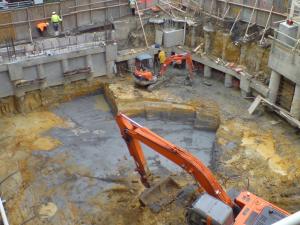Improving the stability of clay for construction

Copyright : wikimedia
This research set out to improve the engineering quality of clay using waste materials and a secret binder ingredient.
Clay is a natural material composed primarily of fine-grain minerals. It consists of tiny particles that have plastic and adhesive properties. Clay also possesses small voids and pores, so it's capable of retaining water. In this condition, it tends to expand and shrink, which can lead to settlement.
When exposed to increments of water, clay tends to soften and liquefy. Clay often causes difficulties in construction with its low strength and stiffness. This has caused serious problems in geotechnical engineering because weak soil may cause damage to the foundation of buildings and cracks along the road pavement.
Due to the rapid growth development of infrastructures facilities in Malaysia, it is impossible to avoid constructing on clay. Clay makes up 20% of the total soils in Peninsular Malaysia. It can be found in the West and East Coast of Peninsular Malaysia. This type of soil is generally classified as marine clay. This clay originates from flooding during ancient times. The sedimentation of seabed was very thick and can be up to 60 metres in depth, or roughly the height of a 20 storey-building. Hence, the construction over clay may experience bearing capacity failure and excessive settlement.
Stabilization of soil using cementitious material becomes optional to solve this problem. Cementitious materials are several binding materials that may mix with water to form a plastic paste.
Ordinary Portland Cement (OPC) is used as a common cementitious binding agent. From a previous study, stabilization of soil using cement was one of the soil treatment applied to improve soil plasticity and workability. Therefore, this research focuses on determination of the strength that can be produced by using waste material ashes as part of the additive mixture.
This will decrease the use of Ordinary Portland Cement (OPC) to help stabilize clay. By doing this, more economical soil mixes can be produced.
The selected waste materials are bottom ash (BA) and fly ash (FA). They are a byproduct from electric power plant. These waste materials are disposed and generally have no economical value.
BA is physically coarse, porous, glassy, granular, greyish and incombustible materials that are collected from the bottom of furnaces that burned coal whereas FA is grey in colour and dust-like material.
It is found that they have pozzolonic properties which make it possible to replace cement in deep soil mixing. On top of that, a secret ingredient has been added to promote better pozzolonic reactions between the additives and clay.
This research was conducted for soil engineering properties and strength test for various inclusions of ashes into the clay soil. The percentage of additives is 5%, 10% and 15% of each ash. Improvement levels were evaluated from the results of unconfined compression test (UCT) carried out at different curing times.
Other soil characteristics like plasticity, particle density and compaction properties were also monitored.
The results showed that by using these admixtures, the strength development can be increased over time. This proved that these admixtures can be promising ingredients in deep soil mixing. By doing so, a high performance clay cement column can be produced in the near future.
Juhaizad Bin Ahmad
Institute of Infrastructure, Engineering & Sustainable Management (IIESM)
UiTM Shah Alam
Email : juhaizad@salam.uitm.edu.my
Media Contact
All latest news from the category: Architecture and Construction
Newest articles

NASA: Mystery of life’s handedness deepens
The mystery of why life uses molecules with specific orientations has deepened with a NASA-funded discovery that RNA — a key molecule thought to have potentially held the instructions for…

What are the effects of historic lithium mining on water quality?
Study reveals low levels of common contaminants but high levels of other elements in waters associated with an abandoned lithium mine. Lithium ore and mining waste from a historic lithium…

Quantum-inspired design boosts efficiency of heat-to-electricity conversion
Rice engineers take unconventional route to improving thermophotovoltaic systems. Researchers at Rice University have found a new way to improve a key element of thermophotovoltaic (TPV) systems, which convert heat…



